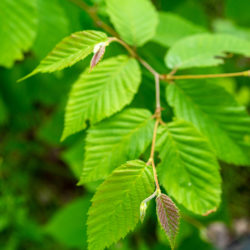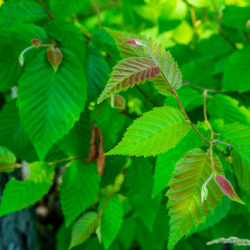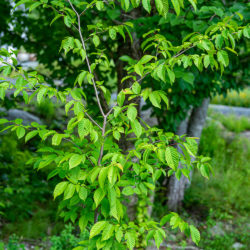Etymology
Carpinus is the Latin name for the European Hornbeam; caroliniana is Latin for “of the Carolinas.”
Native Habitat
Shady woodlands, some adaptability to sunnier sites.
Garden Uses
American hornbeam is useful in a naturalized or woodland setting and as an understory shade tree. It adds interest to the landscape with its smooth gray bark.
Overview
An eastern North American native deciduous shrub or small tree, American Hornbeam typically grows from 12’ - 36’. It is a slow growing understory tree. The name hornbeam references the hardness of “horn” of the wood.
Leaves and Stems
Leaves are simple, alternate, 2–5 inches long, 1–2 inches wide, with upper surface bluish green, dull; undersurface paler, mostly smooth, or with hairs in vein axils only, margins with small sharp teeth. Twigs are slender, gray or red, zigzagged with small buds.
Flowers
Flowers are catkins and appear April-May. Bloom color is red, green, brown. Flowers are wind pollinated and monoecious (both male and female flowers on the same tree).
Fruit/Seed
Fruit is long, hanging in clusters of paired 3-lobed bracts (modified leaves), with each pair of bracts having a nutlet at its base.
Animal Associates
The American hornbeam is a larval host for butterflies including Eastern tiger swallowtail and Striped hairstreak. It is a food source for fruit-eating mammals (deer, rabbits and foxes eat the seeds, bark, wood and twigs) and birds, including bobwhite and wild turkey. Catkins and buds are a primary food source for ruffed grouse.
Propagation
Sow fresh, slightly green seed outdoors in fall or fully dried and stratified (kept at 41 degrees 2-3 months) seed in spring. For dried seeds, collect nutlets in late summer or early fall when bracts have turned a pale, greenish-brown. Spread on screens to dry, then beat inside a bag to separate seeds from chaff. Place fresh seeds in cold storage (stratify).
Ethnobotanical Uses
The wood is used in small-handled toolmaking.
Garden Location
Performance Hall Garden (see garden map)
Sources
Lady Bird Johnson Wildflower Center
Missouri Department of Conservation
Plant Profile by Ivonne Vazquez



